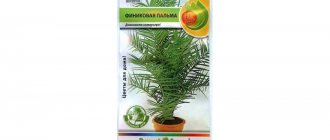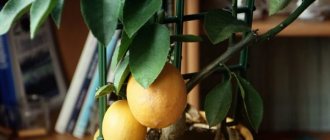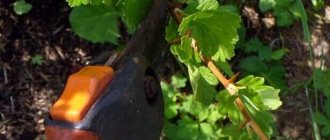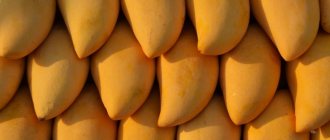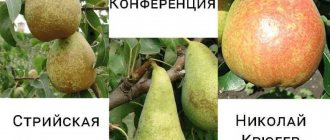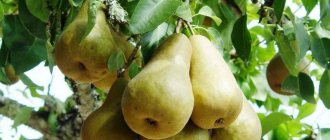In the tropical regions of our planet, the mango tree is considered an important agricultural crop. It has been cultivated there for more than 8 thousand years. The birthplace of this culture is the border areas of India and Myanmar. In Europe, this exotic plant appeared only in the middle of the last century.
What does a mango look like?
In nature, mango (Mangifera indica) is a powerful evergreen tree that grows up to 40 m in height. The crown is wide, spreading, 10–15 m in diameter. Its homeland is the tropics of Southeast Asia. It is especially common in India, Thailand, Vietnam, and Myanmar. Nowadays, extensive plantations exist in the southern states of the USA, Mexico, the Caribbean and Central America, and Australia. Humanity has been growing mangoes for over 4,000 years. In its homeland it is called “fruit of the gods”, “great fruit”, and also “Asian apple”. According to legend, mangoes are a wedding gift from the god Shiva to his future wife Sati.
In nature, a mango tree can grow up to 40 m in height
The mango tree grows quite quickly, but you have to wait 10–15 years for fruiting. But its productive period is 250–300 years.
Mango plantations exist in many countries with tropical climates
It is not possible to grow mangoes in open ground in Russia. The climate and weather conditions are radically different from what the plant is accustomed to. But amateur flower growers have successfully “domesticated” the crop and even manage to get a harvest in “captivity.” In such conditions, the height of the tree is usually limited to 1.5–2 m.
Mango tree can bear fruit for 300 years
Mango leaves are long and narrow, lancet-shaped. The front side is painted bright green and has a glossy shine. The reverse side is lighter and matte. Young leaves have a yellowish, pinkish or reddish tint. At first they look very sluggish, lifeless. Don’t be surprised, this is the norm for the plant, and not some kind of exotic disease. In their homeland they are called “shawl leaves,” hinting that they look like laundry hung out to dry.
Young mango leaves are colored in different shades of reddish-yellow and pinkish - this is the norm for the plant
The juice of the leaves is poisonous. It can cause allergies, cause a rash, and redness of the skin. Therefore, any mango pruning work should only be done with gloves. The place for the plant pot should be chosen so that it is out of the reach of children and pets.
Mango blooms in early spring. The inflorescences consist of many small yellowish, pinkish or pale red flowers and are shaped like a raceme or panicle. They are very long, up to 30–40 cm. Each has at least several hundred flowers, often the number reaches a thousand. They emit a pleasant aroma, a bit like the smell of lilies.
Mango blooms very profusely; one inflorescence can contain up to a thousand flowers.
Video: what a mango tree looks like
Description of fruits
It takes 4–6 months for the fruit to ripen. The appearance of the fruit depends on the variety. There are also small mangoes, slightly larger than a plum, and “record holders” weighing more than 2 kg. The average weight of the fruit is 200–400 g, length varies from 5 to 22 cm. The skin is colored in different colors - from greenish and lime to dark scarlet and reddish brown, including all shades of yellow. Combinations of all three colors are often found. The skin is dense, matte, smooth to the touch, covered with a waxy coating. For ripe fruits, when pressed, it moves, but does not penetrate deeply.
The appearance and size of mango fruit depends on the plant variety
The pulp is bright, saffron, very soft, juicy and sweet, the taste is somewhat reminiscent of a mixture of apricot, peach, pineapple and melon, with a spicy aroma in which notes of lemon and roses can be discerned. Each fruit contains one large seed, hard and ribbed to the touch.
Mango pulp is very juicy and incredibly tasty, has a unique aroma
“Natural” mango fruits do not smell very pleasant. The smell evokes associations with mold, rot, even rotten meat. Many people even develop allergies to this “aroma”. This is explained by the fact that in nature, mangoes are most often pollinated by bats. They spread its seeds. But fortunately, the vast majority of modern varieties bred by breeders are devoid of this unpleasant feature.
Beneficial properties of mango
Mango is not only very tasty, but also healthy. The fruits are valued for their high content of essential amino acids, fiber, unsaturated fatty acids, flavonoids, pectin, vitamins B, A, D and E, as well as for their low calorie content. 100 g contains only 66 kcal, so mango can pleasantly diversify any diet.
Even small mango trees grown at home can produce a bountiful harvest.
In folk medicine, especially in India, mango is used very widely. The fruits are used to improve immunity, to combat migraines and stress, to relieve nervous tension, and also as an antipyretic and anti-inflammatory agent. It is also believed that regular consumption of mangoes is an effective prevention of the development of tumors, including malignant ones. Previously, it was recommended to eat them in order to avoid contracting cholera and plague.
Mango leaf infusion has been scientifically proven to have antibacterial properties. It can be used instead of mouth rinses. It is also recommended to drink it for diabetes of any type to avoid retinal detachment and normalize blood pressure.
There are also contraindications. Mango should not be combined with alcohol or abused if you do not want to develop persistent stomach and intestinal upset. Those who are prone to allergic reactions should try the fruits carefully - skin rashes, redness and swelling of the lips are possible. It is recommended to cool the mango before serving. Thanks to this, the specific oiliness of the pulp, which not everyone likes, is softened.
Video: health benefits of mango
General features of the majestic plant
The cork tree belongs to the Beech family and is an evergreen plant. Its height often exceeds 20 meters. The diameter of the trunk of an adult tree is 100 cm. Its leaves are dark green. The edges are jagged. The shape is oblong. The outer side of the leaf plate has a shiny surface and a grayish tint. Overall, the leaves and branches create a wide, spreading crown.
When May comes, cute flowers appear on the tree. Over time, fruits - acorns - are formed from them. They grow on one stalk, 2 or 3 pieces each. They stretch up to approximately 3 cm, and a thickness of one and a half centimeters. The fruits ripen within one calendar year.
The cork tree grows very slowly. When he is about 25 years old, he is considered to have entered the period of maturity. The lifespan of the plant is approximately 300 years. Some specimens live up to 400. If only people could live that long!
On this topic:
BACK
FORWARD
1 of 18
In nature, there are two types of such trees:
- cork tree "Real";
- cork oak "Western".
Its distant relative grows in the Far East - Amur Velvet, which is also called the cork tree. Although its bark is used for industrial purposes, it is inferior in quality to the original plant.
The places in nature where the cork tree grows are at an altitude of 500 m relative to sea level. Most often found in the Mediterranean, as well as in Spain, Portugal, Crimea and the Caucasus. We can say that people from different countries received a valuable gift, so there will be enough wine corks for everyone.
The peculiarity of this type of oak lies in its unique bark. Inside it there are closed pores that can hold liquid in the middle of the thick trunk. Therefore, the tree miraculously tolerates drought - a common occurrence in warm countries. A photo of a cork tree in natural conditions causes special admiration among lovers of green spaces on the earth.
The cork tree propagates by sprouting acorns or seedlings. Although young seedlings do not always adopt the characteristics of the mother tree. Therefore, when growing artificially, gardeners select only sufficiently mature and large acorns.
On this topic:
BACK
FORWARD
1 out of 10
How to plant mangoes correctly
In the homeland of mangoes, the temperature remains virtually unchanged throughout the year. The climate is also characterized by high humidity. This must be taken into account when choosing a location for the plant. And also the fact that it requires long daylight hours. In most of Russia, natural light will not be enough, so you will have to use ordinary fluorescent or special phytolamps, extending the daylight hours to 14–16 hours.
Mangoes are placed near a window facing south or southeast. If the tree was purchased from a special nursery or store, there is no need to replant it immediately. It is better to give him 2-3 weeks to adapt to new conditions.
When growing mangoes at home, you need to provide the plant with 14–16 hours of daylight.
The soil
It does not make any special demands on the quality of the soil, but it is desirable that it be light and loose. The only prerequisite is that the substrate must be sufficiently acidic. You can purchase special soil for azaleas, gardenias, and hydrangeas in the store, or annually add peat to the soil, add a few drops of apple cider vinegar or citric acid crystals to the water for irrigation.
The soil for growing mangoes should be acidic (pH 4.0–5.5), any store-bought substrate is suitable for plants that prefer similar soil
Experienced gardeners mix the soil themselves. The simplest option is peat chips, ordinary garden soil and coarse river sand (1:2:1). The latter can be replaced with any baking powder - perlite, vermiculite, dried sphagnum moss or coconut fiber.
The root system of mangoes is powerful and developed. In nature, its roots go 6–10 m into the soil. Therefore, you will need a fairly large pot or even a tub. It is advisable that the container be ceramic or wooden - natural materials allow air to pass through. It is good if the pot has a thick bottom, otherwise the mango roots may simply break through it.
The mango tree has a powerful root system, so the pot for the plant must be massive and stable, with a thick bottom
The process of planting and replanting a plant
The best time to plant and replant mangoes is late spring or early summer. There is no need to carry out the procedure too often: for an adult plant, once every 3–4 years is enough. When it is no longer physically possible to replant a tree due to its size, they limit themselves to removing the top 5–7 cm of soil and replacing it with fresh substrate.
There is nothing complicated about the transplant itself:
- The mango is removed from the container along with a lump of earth. This will be easier to do if you water it thoroughly about half an hour beforehand.
- The new pot is filled with soil about a third, not forgetting the drainage layer at the bottom.
- The tree is transferred to another container and covered with soil. Its base should be flush with the soil surface or slightly lower. There is no need to compact the soil too much; mango prefers a loose substrate.
- Then the plant is watered moderately and transferred to partial shade for 3–5 days or otherwise protected from direct sunlight.
The mango tree is replanted as it grows; for adult plants, the top layer of soil is only changed
Growing from seed
Mangoes can be grown at home. It will not be as high as in natural conditions, its fruiting is also in question, but you will enjoy the process.
- In the spring and summer, purchase a mango fruit. It is better if it is ripe or even overripe.
- Carefully remove the pit, freeing it from the pulp. The pit of overripe fruits usually has a crack. Using it, we extract the seed. If the bone does not have a crack, it will have to be opened by making an incision.
Opened mango seed with seed - Seed germination is carried out in soft water, filling 1/3 of a glass with it. The water is changed once every 2 days.
Soon (in a week or two) a sprout will appear.
After waiting a couple of weeks, it is planted in a separate deep container. The root will need a lot of space.
- Drainage is placed at the bottom of the pot, soil for flower plants is poured on top, making a hole in it for the seedling, where the seed is placed with the root down, completely covering it with soil and placing it in a warm and bright place.
- We wait for the sprouts to appear, monitoring the soil moisture.
When leaves appear, they are periodically irrigated with warm water. The plant is watered regularly. Overdrying the soil is detrimental to small mangoes.
Recommendations for caring for mangoes
If the mango is provided with optimal conditions, the plant does not need particularly careful care. The most important thing for him is that there is enough light. When it is deficient, the tree weakens, its immunity decreases, and it becomes more susceptible to attacks by pathogens and pests.
Watering
Mango is a moisture-loving plant, but if you over-water it, the roots can rot. Therefore, the soil must be constantly kept slightly moist. Young trees under five years of age are especially sensitive to drying out. Their leaves immediately droop and begin to fall.
If the leaves of a young mango tree begin to dry out and fall off, the number of waterings should be increased.
Immediately after flowering, if fruits have set, watering is reduced to the minimum required. In the previous mode, it resumes only after the harvest. Usually once every 3-5 days is enough, but it depends on how warm it is outside. In extreme heat, daily watering may be required.
Use water only at room temperature and left to sit for at least a day. Mangoes are sprayed with it daily or at least once every 2-3 days. The plant prefers high (70% or more) air humidity, as in its native tropics. Special humidifier devices, wet moss, expanded clay, coconut fiber placed in the tray of the pot, as well as containers with cool water placed around the room or the company of other plants will help to provide it.
Top dressing
Mangoes definitely need fertilizers, but you shouldn’t be overzealous with them. Their excess in the soil provokes salinization, which, in turn, inhibits the development of the tree.
You can use both mineral and organic fertilizers. In the spring, before flowering, it is advisable to water the tree once every 12–15 days with a solution of complex fertilizer for citrus or palm trees or vermicompost. They contain enough nitrogen, which stimulates plants to actively form green mass.
After flowering, it is better to use organic fertilizers at the same frequency. An infusion of manure, bird droppings, nettle or dandelion leaves works well. Prepare it for 3–5 days in a container with a tightly closed lid; before use, dilute it with water in a ratio of 1:10 or 1:15 (if it is droppings). In mid-autumn, feeding is stopped.
The mango tree can be fed with any fertilizer for citrus fruits.
In addition to nitrogen, phosphorus and potassium, mango also needs other microelements. Therefore, 2–3 times per season, its leaves are sprayed with a solution of boric acid, copper sulfate and zinc sulfate (1–2 g per liter of water).
Tree pruning
Mango trees vary in size in nature. Therefore, trimming it is an absolutely necessary procedure, otherwise it simply will not fit into most modern apartments. As a rule, its height is limited to 1.5–2 m, but experienced gardeners even manage to form bonsai from mangoes.
Mangoes at home need to be trimmed; experienced gardeners even form bonsai from the tree
The crown of a mango, as a rule, is not too thick; it takes on a beautiful symmetrical shape with almost no effort on the part of the grower. You just need to remember that the fruits ripen at the ends of the branches, and cut off thin, deformed shoots that are growing downward or clearly stick out beyond the contours of the chosen configuration. They are cut off almost to the growth point, leaving “stumps” of 2–3 cm. At the same time, this will help thin out the crown if it is too thick near the trunk. Mango tolerates pruning well and recovers quickly after it. The best time for the procedure is autumn, 2-3 weeks after harvest (if there was one).
Nutritional value
100 g of green young mango leaves contain the following nutrients: 3% protein, 0.4% fat, 16.5% carbohydrates, 1.6% dietary fiber, 29 mg calcium, 72 mg phosphorus, 6.2 mg iron, 0.04 mg thiamine, 0.06 mg riboflavin, 2.2 mg niacin, 53 mg ascorbic acid, 1490 IU vitamin A. It’s easy to guess that fresh leaves contain a lot of moisture. It makes up 78.2% of the total mass.
In addition to the above, mango leaves contain the enzyme papain, which is also present in papaya. This explains the wide range of beneficial properties of mango leaves, one way or another related to digestion.
Mango grafting
Grafting is a method of propagation that is guaranteed to preserve all the varietal characteristics of the fruit characteristic of the donor plant. Grafted mangoes begin to bear fruit after 2–3 years. Until this time, it is better to remove the flowers on them so that the tree can form a developed crown.
Grafting is carried out in the second year of life, when the trunks of mango seedlings grown from seeds reach approximately the diameter of a pencil. The best time for the procedure is mid or late summer.
Grafting with cuttings
You can graft both a cutting (the tip of a shoot 10–15 cm long) and a separate growth bud (the so-called budding). In the first case, the top of the rootstock and the base of the cutting are cut at an angle, the cuts are combined and the entire structure is fixed with adhesive tape, electrical tape or a special grafting tape. You can also insert a rootstock cutting into a split in the scion.
Cuttings from fruit-bearing mango trees are grafted onto seedlings grown from seeds
Budding
For budding, you will need a growth bud, cut from a fruiting tree along with a “shield” of surrounding tissues about 2 mm thick and 1–2 cm in diameter. Cut it with a disinfected scalpel or razor blade, trying to touch it as little as possible in the process. Then the resulting “shield” is inserted into an X- or T-shaped cut on the bark of the rootstock seedling, wrapping the grafting site with polyethylene so that the bud itself remains outside.
For budding, take a growth bud from a fruiting tree, cut together with a shield of surrounding tissue about 2 mm thick.
The grafted seedling is covered with a plastic bag, with several holes made in it for ventilation, and transferred to the brightest and warmest place in the apartment. Leaves and shoots below the grafting site are removed only when it becomes clear that the procedure was successful.
Diseases, pests and their control
Mango, like other fruit plants, can be susceptible to diseases and pest attacks.
Mango diseases
Mangoes do not have any specific diseases brought from their historical homeland, but the plant can be affected by a number of fungal diseases.
Anthracnose
Most often, the fungus attacks plants with weakened immune systems, penetrating into tissues through the slightest mechanical damage. Rapidly growing brick-colored spots with a yellowish border appear on the leaves; depressed brownish ulcers with a purple rim appear on the trunk and shoots, gradually changing color to brown. At low humidity, their surface cracks, at high humidity it turns black and rots.
To combat anthracnose, as well as other fungal diseases, use copper-containing preparations - fungicides
For prevention, Fitosporin-M, Trichodermin, and Gamair are added to irrigation water once a month. The soil is dusted with crushed chalk or activated carbon. Having discovered characteristic symptoms, use any fungicides - Cuprozan, Oxychom, Previkur, Skor, Acrobat-MC and so on. 2-3 treatments with an interval of 15-18 days should be enough.
Bacteriosis
The edges of the leaves darken and the surface wrinkles. They turn black, but do not fall off. Dark brown rings are visible on the cut shoots.
Plant leaves affected by bacteriosis darken and wrinkle
For prevention, before planting, seeds are pickled for 10–15 minutes in a solution of Planriz, Fitolavin, Agata-25K. Having discovered a disease, you need to immediately cut off all even minimally affected leaves and shoots, capturing 5–7 cm of healthy-looking tissue. Sections are disinfected with a 2% solution of copper sulfate. Irrigation water is replaced for a month with a pale pink solution of potassium permanganate. Alirin-B and Trichodermin granules are added to the soil.
Powdery mildew
The leaves are covered with a layer of grayish-white coating, similar to spilled flour. Gradually it darkens and thickens, and drops of cloudy liquid begin to ooze from the affected tissues. The shoots become deformed and thicken. As a rule, the infection spreads from the lowest leaves. The fruits may also suffer - they crack and rot.
Powdery mildew seems like a harmless coating that can be easily wiped off, but in fact it is a dangerous disease that can affect not only leaves, but also fruits
For prevention, mangoes are sprayed once every 2-3 weeks with a solution of any fungicide of biological origin (Planriz, Fitosporin-M, Alirin-B). You can also use folk remedies - an infusion of wood ash, a solution of soda ash, kefir diluted with water or whey with the addition of iodine (10 drops per 10 liters). To combat powdery mildew, the drugs Bayleton, Tiovit-Jet, Topaz, Topsin-M are used.
Mango pests
In addition to fungal diseases, pests that feed on plant juices pose a danger to mangoes.
Spider mite
The tips of the shoots, young leaves, and inflorescences are intertwined with thin translucent threads reminiscent of a cobweb. Multiple small beige dots appear on them, and gradually the affected tissues become discolored and dry.
Spider mites are not insects, so special preparations are used to combat them - acaricides
Since the spread of pests is facilitated by heat and high humidity, if the mites have not yet had time to breed, you can get rid of them by daily spraying the tree and the surrounding air with clean water. Folk remedies (infusion of onion and garlic pulp, decoction of cyclamen tubers) can only be used for prevention.
To combat the pest, special preparations are used - acaricides (Apollo, Neoron, Omite, Vertimek). It will take 3-4 treatments, and the product needs to be changed each time. The pest quickly develops immunity. The intervals between procedures (5–12 days) depend on the weather outside. The hotter it is, the more often you need to spray the mango.
Shchitovka
Small brownish or beige oval-shaped growths appear on the underside of the leaves and on the shoots. Gradually they swell, the surrounding tissues acquire a reddish-yellow hue. In especially severe cases, the soil in the pot turns black.
It is useless to fight scale insects with folk remedies - the pest is reliably protected by a durable shell
Visible scale insects are removed manually, after lubricating their shells with kerosene, turpentine, and machine oil. Then the tree is given a shower and treated with Actellik, Fosbecid, Fufanon. Folk remedies against scale insects are ineffective - the pest is reliably protected by a durable shell. For prevention, mango leaves are wiped once a week with a soft cloth soaked in vodka and sprayed with infusion of onion, garlic, and hot red pepper.
Aphid
Small yellow-green or black-brown insects cling to the tops of shoots, young leaves, and buds. At the same time, the appearance of a transparent sticky coating is noted. The aphids feed on the sap of the plant, the affected tissues turn yellow, the leaves dry out and fall off.
Aphids are one of the most omnivorous pests of indoor plants; despite the poisonous juice, they will not disdain mango leaves either.
Effective prevention of aphids is infusions of any herbs with a pungent odor. As raw materials you can use wormwood, tansy, tomato and potato tops, calendula, lavender, as well as onions, garlic, lemon peel, tobacco and so on. They will also help get rid of aphids if they have not yet multiplied en masse. In this case, the frequency of treatments will have to be increased from once a week to 3-4 times a day. If there is no effect, use any general insecticides - Inta-Vir, Mospilan, Tanrek, Iskra-Bio, Confidor-Maxi and so on.

